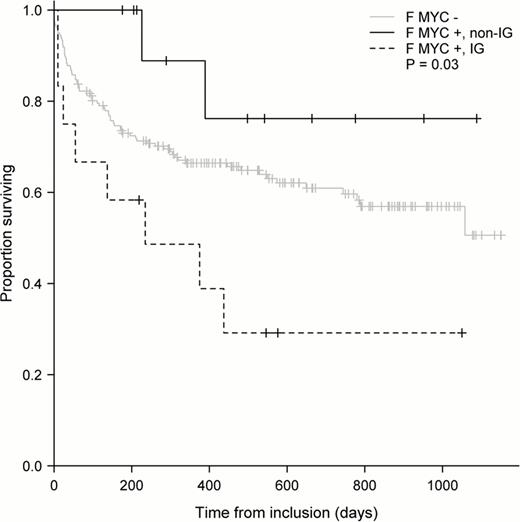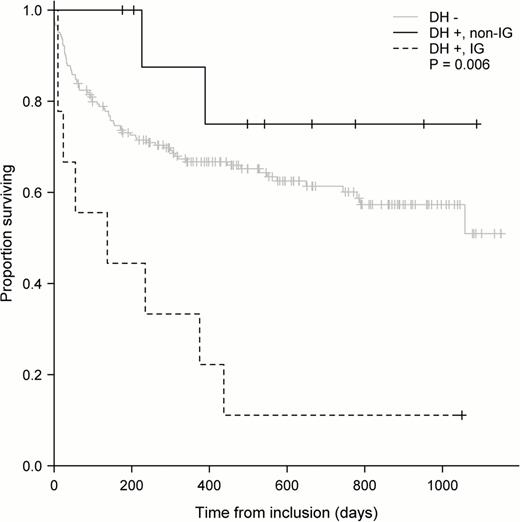Abstract
Abstract 542
MØP and AOG shared the first authorship.
In large B-cell lymphoma (LBCL) chromosomal translocations involving the MYC protooncogene (8q24) with or without concurrent BCL2 translocation (double hit) have been associated with inferior survival. We recently found in a prospective cohort of LBCL patients that double hit MYC/BCL2 translocations had no impact on overall survival (Pedersen et al., Eur.J.Haematol. 2012). However, further stratification of patients with double hit MYC/BCL2 translocation indicated an inferior survival related to immunoglobulin MYC translocation partner gene (MYC-IG). We sought to confirm this in a larger prospective cohort of LBCL patients.
All patients diagnosed with LBCL (diffuse large B-cell lymphoma, DLBCL, or B-cell lymphoma, unclassifiable, with features intermediate between diffuse large B-cell lymphoma and Burkitt lymphoma, BCLU), at Dept. of Pathology and subsequently treated at Dept. of Hematology, Copenhagen University Hospital in Herlev, were prospectively collected from 2009–2011. Tumors were classified according to morphology and immunophenotype (2008 WHO classification). Chromosomal translocations were examined with FISH, including BCL2, MYC, MYC/IGH, kappa and lambda probes. Cases which were MYC/IGH fusion signal positive or MYC split signal positive + kappa or lambda split signal positive were classified as MYC-IG. Clinical data were collected from patient files. A total of 237 patients (163 primary LBCL, 49 transformed LBCL, 25 relapsed LBCL) were included.
MYC translocation was found in 28/225 patients, with translocation partner gene MYC-IG in 12/24 patients and MYC-nonIG in 12/24 patients. Double hit MYC/BCL2 was found in 23/228 patients, with translocation parter gene MYC-IG in 9/19 patients and MYC-nonIG in 10/19 patients. Cox regression models were performed for calculating p-values and survival curves (Fig. 1+2). The presence of MYC translocation or MYC/BCL2 double hit translocation showed no correlation with survival. However, stratification according to MYC translocation partner gene showed an inferior overall survival related to MYC-IG compared to MYC-nonIG (p=0.03), and to MYC translocation negative (Fig. 1). Among patients with double hit MYC/BCL2 translocation, a similar picture evolved where MYC-IG/BCL2 had an inferior overall survival compared to MYC-nonIG/BCL2 (p=0.006) and MYC/BCL2 translocation negative cases (Fig. 2). Most patients were treated with standard Rituximab containing chemotherapy and treatment was comparable between the groups.
MYC translocation, with or without concurrent BCL2 translocation, was associated with inferior survival only if MYC had immunoglobulin translocation partner gene, in this prospective cohort of LBCL patients. This suggests that prognostic stratification by MYC and MYC/BCL2 translocations should include examination of MYC translocation partner genes. An overrepresentation of transformed cases which was observed in the MYC-nonIG group could lead to an underestimation of the prognostic effect of MYC-IG.
Survival curves comparing LBCL with translocations, MYC-IG, MYC-nonIG and MYC translocation negative.
Survival curves comparing LBCL with translocations, MYC-IG, MYC-nonIG and MYC translocation negative.
Survival curves comparing LBCL with double hit MYC-IG/BCL2 translocation to MYC-nonIG/BLC2 and MYC/BCL2 translocation negative.
Survival curves comparing LBCL with double hit MYC-IG/BCL2 translocation to MYC-nonIG/BLC2 and MYC/BCL2 translocation negative.
No relevant conflicts of interest to declare.
Author notes
Asterisk with author names denotes non-ASH members.



